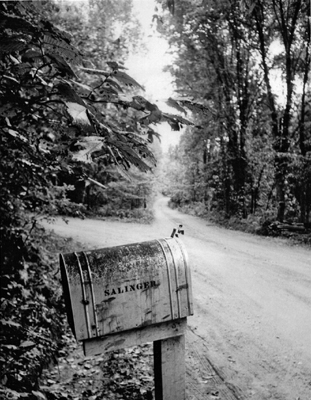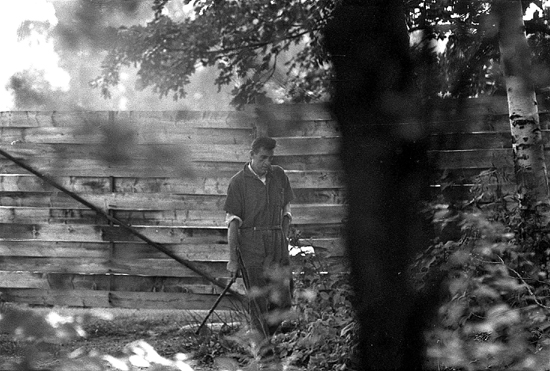
The road to Salinger’s house and his mailbox, photographed by Ted Russell for Life magazine in 1961.

The road to Salinger’s house and his mailbox, photographed by Ted Russell for Life magazine in 1961.
MICHAEL McDERMOTT: Very few photographs have been taken of Salinger. In 1960 Newsweek was the first magazine to really look deeply into him. They hired a local photographer, who tried to get a photograph of him. The photographer parked his car near Salinger’s house and was ready to ambush him; lo and behold, Salinger and his daughter—I think she was about four years old at the time—were walking down the road. The photographer walked up to Salinger, introduced himself instead of just grabbing the shot, and melted in his presence. The photographer said Salinger was so polite that he felt ashamed telling him he was in Cornish to take a picture of him for Newsweek. Salinger thanked the photographer for not trying to sneak a picture of him and then said, “My method of work is such that any interruption throws me off. I can’t have my picture taken or have an interview until I’ve completed what I set out to do.” That’s a remarkable statement, and the photographer left without getting the picture.
MARC WEINGARTEN: There was a bounty on Salinger’s head. Everyone wanted a photograph of this guy, and no one could get it. Time tried. Newsweek tried repeatedly. Nothing. Finally, a photographer at Life magazine named Ted Russell was given the assignment and a deadline of three days to get a photo of Salinger or pack it up and come home.
TED RUSSELL: I was a Life photographer and had been assigned by Life to shoot at the U.N. the week in the fall of 1961 that Dag Hammarskjöld, the United Nations secretary general, was killed in a plane crash in the Congo. I got a phone call from an editor at Life asking me to leave and go up to New Hampshire and shoot J. D. Salinger. I didn’t know much about him at that time. I hadn’t read Catcher in the Rye. It became well known when I was in Korea [during the Korean War]. I wasn’t that familiar with him or his books, or of the fact that he was supposedly a famous recluse.
[The editor at Life] said that he hadn’t been photographed for a decade, and he was very reclusive. She said if you get a picture of him I’ll eat my hat, so that was something of a challenge. I went up there and did my best to get a picture of this reclusive man. The editors put a three-day limit on the job. I was being paid by the day, a hundred a day. And they said go up there and hang out; if it’s more than three days, forget about it.
The editor gave me some written notes. The Life people were very thorough in their research; they gave me very specific directions on how to find him: go over the covered wooden bridge and drive a mile and a half, take the left-hand fork to the dirt road, et cetera, et cetera. They described the house as being hidden away in this wooded area.
I followed those very well-researched directions in the car I rented. I saw the Salinger mailbox they described, with his name on it. I drove past the house and parked a few hundred yards down the road. I tried to be as unobtrusive and discreet as possible. You couldn’t exactly walk down that dirt road with six cameras hanging around your neck. I put my camera in a shopping bag. I looked like a regular guy.
I found a spot with underbrush that provided me a hiding place. Fall hadn’t set in yet, and there was plenty of underbrush that gave me good cover. The challenge was not to be seen, so I took advantage of the terrain, hiding in the bushes much in the way that one would if one were hunting an animal. Patience is very important.
I stayed in a hotel in Windsor, across the river from Cornish, New Hampshire. I would drive to Cornish in the morning, find my little hiding place in the bushes, and stay there all day, shivering, and come back the next day until I ran out of daylight. I didn’t get up there too early in the morning, but I’d stake out pretty much all day. It was very cold and rainy, and I had a horrible cold bordering on the flu. I waited in that spot for two and a half days. It was miserable. On the third day, he came out very briefly to let his dog out and that was just enough time for me to get off a half-dozen frames. One of my favorite pictures was a photo of his dog with his nose stuck beneath the fence. I thought it was funny that Life captioned that photograph as “Salinger’s dog takes an un-Salinger-like peek under the fence.”
I was using a Pentax 300-millimeter lens handheld. It was one of the first single-lens reflex [cameras] to be widely available. I don’t know what the distance was, but I was pretty close. You can tell by the size of the image that with a 100-millimeter lens you can’t be too far away. It was maybe 150 feet away. I was afraid that I was close enough that he might be able to hear the clicking of the shutter.
I’ve always felt somewhat bad about intruding on Salinger’s privacy. I did it because it was a challenge; it was an assignment that I’d been given. It was my job to do the assignment to the best of my ability, solve the problems, and do it. But I always had pangs of conscience.
A guy goes to that much trouble to stay out of the limelight—I always thought, gee, I should have left the poor guy alone. I had misgivings. I became offended by the paparazzi people chasing Jackie Kennedy and Jackie Kennedy’s children and all the paparazzi people today who descend on Britney Spears. Hanging out and stalking celebrities is a sleazy way to make a living. I really never felt that good about having intruded on his privacy in the way that I did. My one comfort was that if Salinger knew how cold and miserable I was, suffering the two and a half days to get those damn pictures, he probably wouldn’t have minded as much. He could take comfort in knowing I suffered out there for that photo.

Salinger outside the fence of his house, where he lived from 1953 to 1967. Life magazine photo, September 1961.
MICHAEL McDERMOTT: It is truly a paparazzi photo, but Ted Russell has an intuitive ability to compose apparently anything that’s in front of him and make it beautiful. The balance of the photograph is nice. The dark bar is very symbolic of a Salinger mood. Salinger’s wearing his characteristic jumpsuit—his uniform for writing and for gardening. When you see it close up, you can actually see the dark circles on Salinger’s eyes—this haunted look.